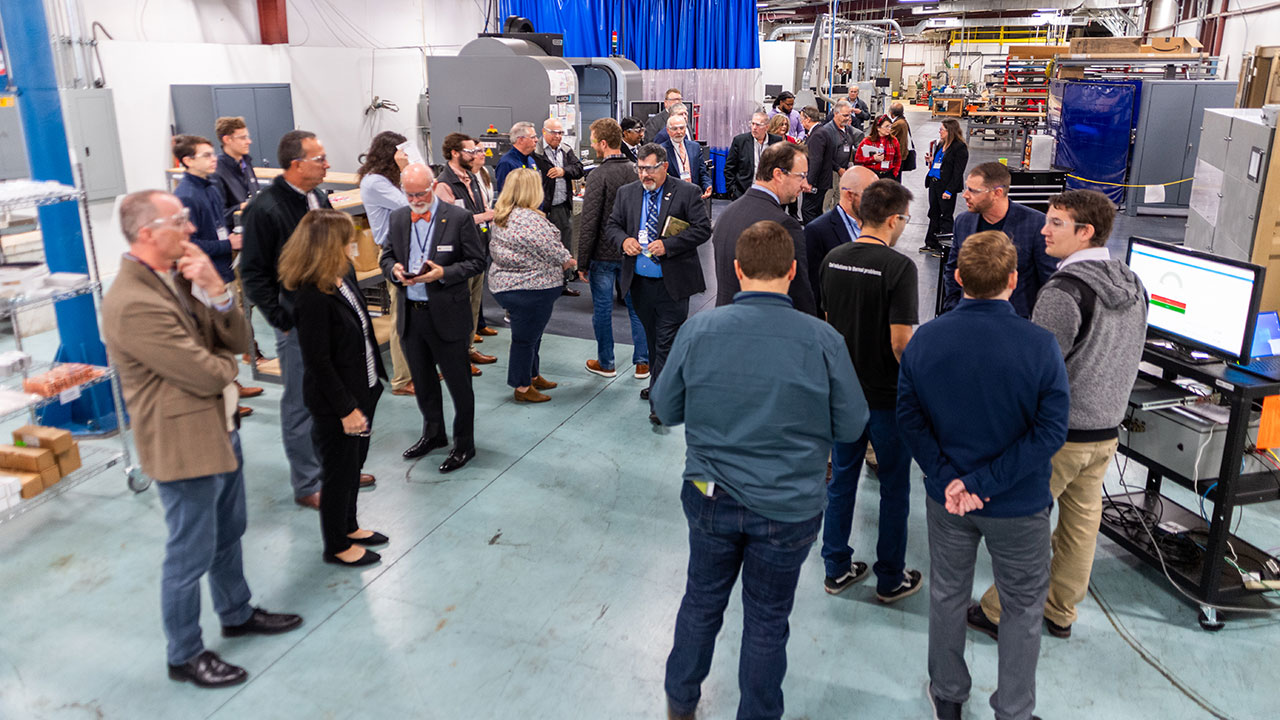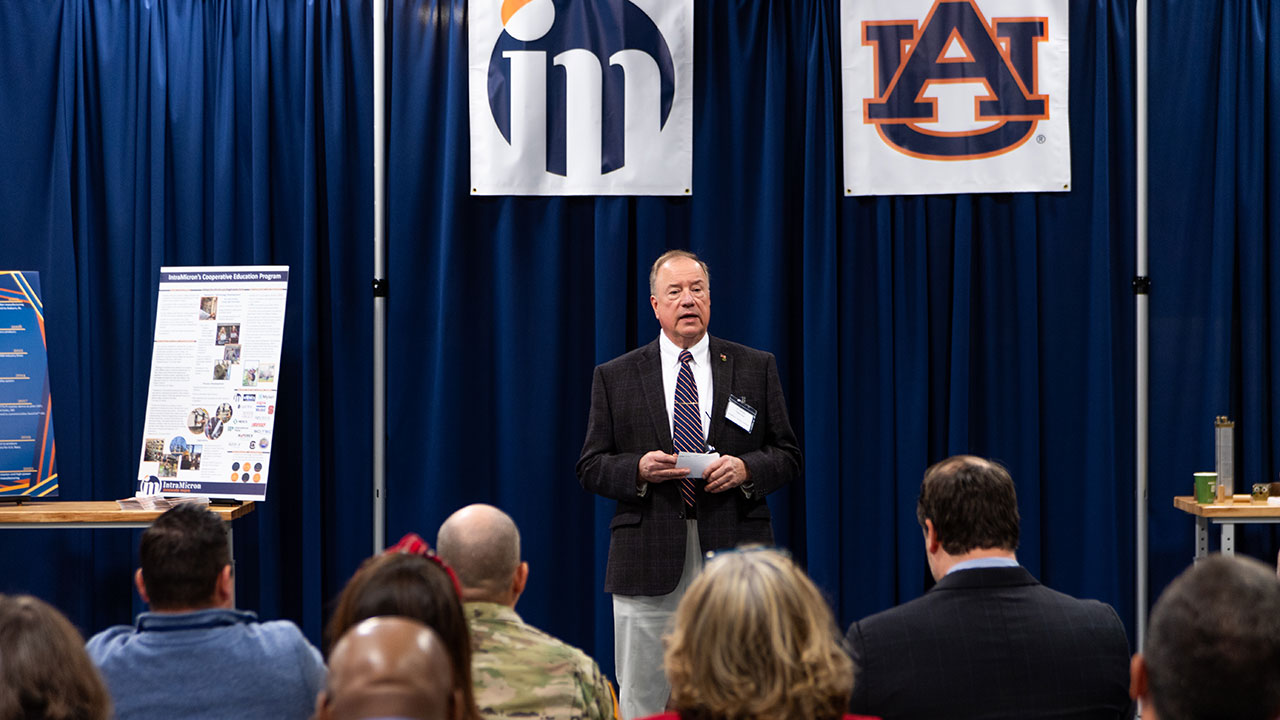Auburn and IntraMicron demonstrate high power battery for next-generation defense applications
Published: Dec 12, 2023 3:15 PM
By Joe McAdory
Generating dynamic, high-energy pulse power is one thing. Doing so while keeping batteries cool and safe, however, has been another.
Auburn University and IntraMicron Inc., a partnering engineering technology development company, showcased a revolutionary means to safely meet the extreme demands of pulse-power electrical systems tailored for next-generation defense missions at a special demonstration on Dec. 7. There, guests witnessed emulated pulse-power mission load discharges powered by a cutting-edge, 1,000-volt lithium-ion battery pack, as part of the team’s ongoing efforts to enhance the nation’s national security and defense posture.
“We have one of the world's largest lithium-ion batteries that can discharge safely at higher, or faster, power levels than any other lithium-ion battery system available,” said Bruce Tatarchuk, IntraMicron co-founder and CEO who serves as director of Auburn University’s Center for Microfibrous Materials Manufacturing and the Charles Gavin III Endowed Professor in the Department of Chemical Engineering.
IntraMicron’s battery and cooling system, in conjunction with other cooling systems developed for the load itself, are coupled together, courtesy of another thermal industry leader, Rocky Research/Honeywell.

“When you discharge a battery at its peak power, half the energy goes into the electrical load and half is generated as heat inside the battery,” Tatarchuk said. “This is 1,000 volts and 800 amps, and that's an 800-kilowatt battery. Our technology provides a safe and effective means to remove that heat, which prevents one battery from getting so hot that it might blow up and then cause all the other 275 batteries in the pack to ignite as well.”
“We are the leaders in this battery pack and design, and we hold U.S. and worldwide patents. It's our baby,” Tatarchuk added.
This innovative system is designed with maximum safety precautions to prevent battery propagation failures, Tatarchuk said, while enabling cells to operate at peak current and power outputs. Leveraging thermal management, this battery-thermal technology enables up to a four-fold increase in power density, setting the stage for next-generation pulse power requirements. Thermal energy storage provides a high-density, consistent cooling capability for directed energy or other mission systems and power requirements.
“From a research standpoint, we at Auburn University focus heavily on societal impact and improving the quality of life, driving our economy and securing our nation,” said Steve Taylor, vice president for research and economic development at Auburn University. “There's a significant amount of national security work that Auburn does across engineering, science, math and veterinary medicine. IntraMicron is a part of that overall effort in manufacturing, helping to make sure that we have the appropriate industrial base in this country to defend our economy. Making strategic investments in research faculty, making investments in our campus research infrastructure and making investments in research programs can produce technology we need to defend ourselves. And, in this case, continue to drive our economy forward and keep America safe.”

Tatarchuk noted that IntraMicron’s battery project also has benefited from the support of Mike Rogers (R-Saks), who represents Alabama’s Third Congressional District and serves as chairman of the House Armed Services Committee. Rogers’ team was among the guests invited to the IntraMicron demonstration.
“Congressman Rogers and his staff work tirelessly to ensure our military is properly funded and tooled with the defense systems necessary to deter and combat threats to the homeland and abroad,” Tatarchuk said. “We’re honored that he recognizes our hard work and that it has the opportunity to make a contribution to this great country.”
IntraMicron, founded in 2001 to commercialize microfibrous materials technology developed at Auburn University, has also developed conductive additives used by the airline industry to eliminate static charging, state-of-the-art gas masks worn by NATO and U.S. soldiers, catalyst systems producing renewable fuels from wastes, metallic filters for chemical and pharma production and the most powerful and safest lithium batteries on the planet.
Tatarchuk said the overriding message isn’t just about IntraMicron, or Auburn, and a new technology. Instead, “it’s about collaborative teamwork and a keen eye on the needs of our stakeholders.”
“You'll see Auburn co-op students and graduate students working side-by-side at IntraMicron and then you'll see staff engineers who are former co-op students,” Tatarchuk said. “The military is concerned about workforce development and the strategic supply and access to people versed in technology. The fact that we can align the student educational experience with the critical workforce needs of the future is a big deal.
“Here, we've got a university and a small spinoff business working together. We're not just talking about it. We're really doing it. We are demonstrating that it’s not just technology and the group of people collaborating. It's the overarching platform and the model we're addressing. Who will this impact? Research targets that have societal benefit… this one being national defense,” he added.


Bruce Tatarchuk, professor of chemical engineering and CEO/co-founder of IntraMicron, explains the importance that battery cooling has on pulse-powered systems.


